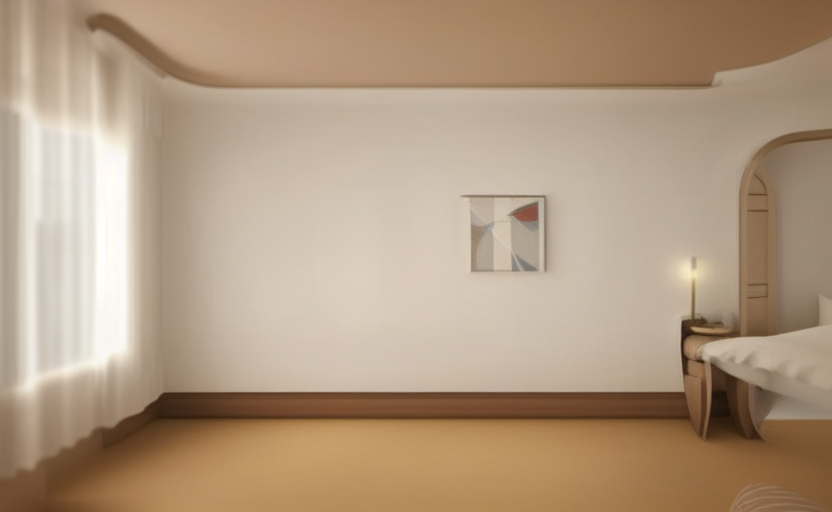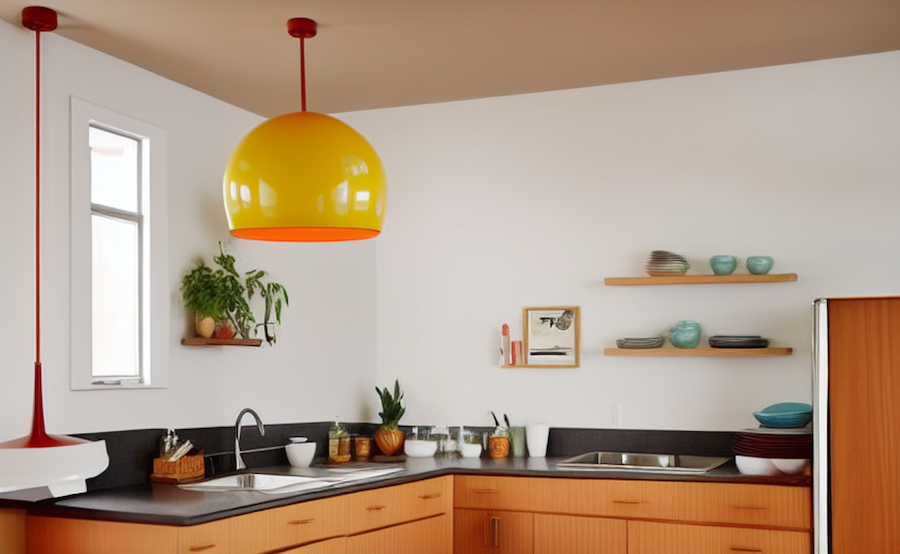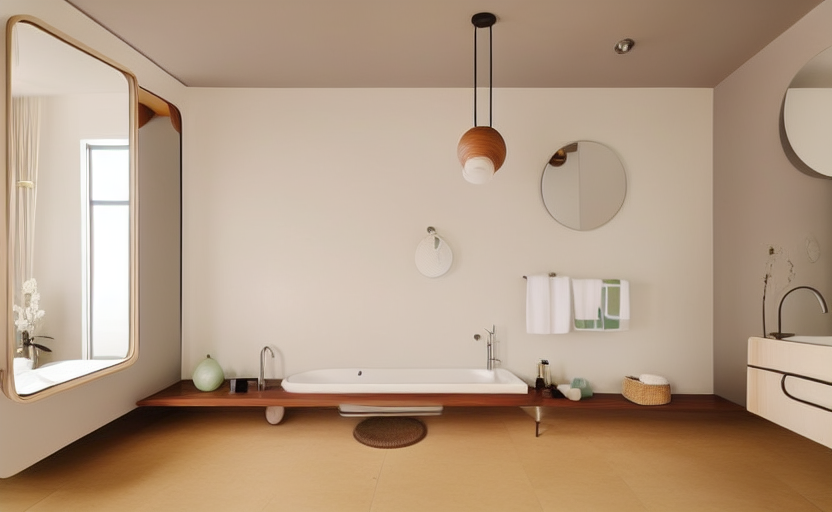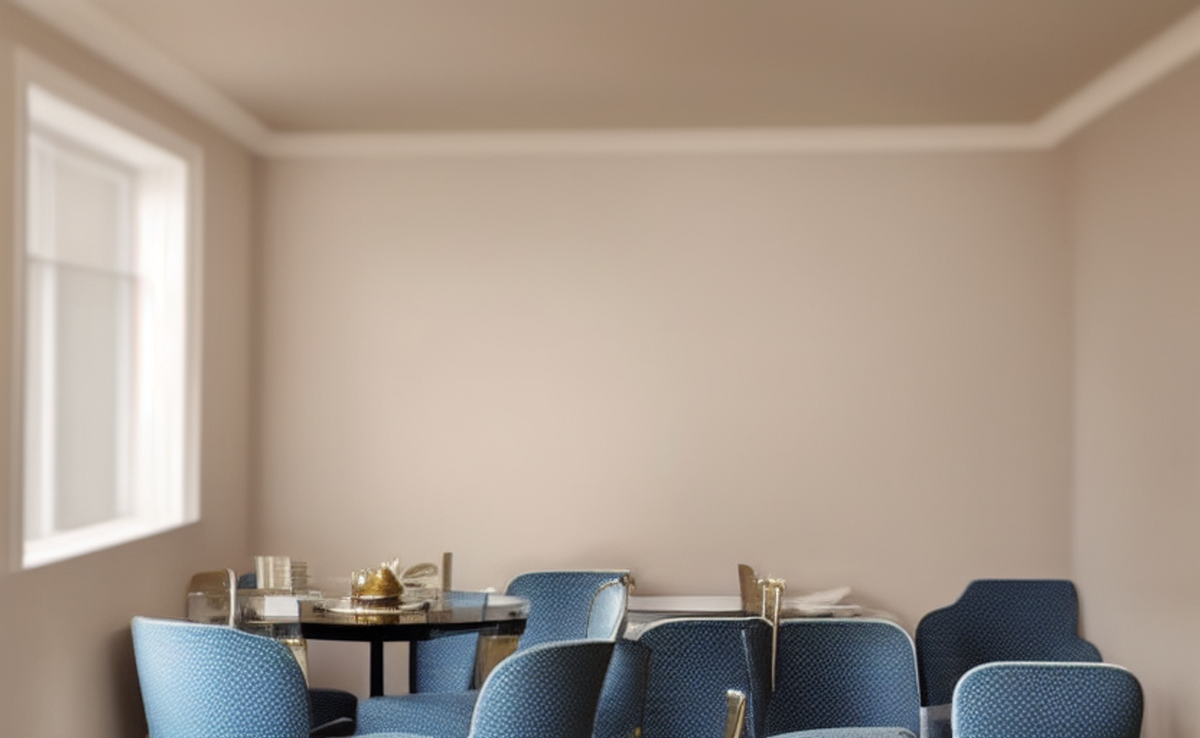Los Angeles designer Shaun Crha and I were reviewing a render for a midcentury modern bathroom when we noticed something missing. Statement pendant light? Check. Sleek bathtub? Check. Toilet? Nowhere to be seen. “Yeah, you’d probably need that,” said Crha with a laugh.
Neither Crha nor I had designed the space—an algorithm was calling the shots. I’d enlisted him to help me test out a new artificial-intelligence-powered design tool called Interior AI. We were simply uploading pictures of empty rooms, selecting basic prompts (“midcentury modern bathroom” or “cottagecore dining room,” for example) and watching the machine go.
At first, the results appeared underwhelming and occasionally confusing. The program could quickly generate images that looked vaguely like a proper room, but any more than a quick glance would reveal absurdities. Chair legs would often blend together into an abstract spiderweb. Light fixtures jutted out at odd angles from the middle of a wall. Sometimes the rooms were oddly spare, other times crammed full of furniture, and the occasional necessity—a toilet, for example—went missing.
Crha seemed amused but not overly impressed by Interior AI—he humored its creations the way one might react to drawings by a precocious five-year-old. Then, I tried tweaking a setting on the site’s dashboard, going from “interior design” mode to “freestyle,” essentially giving the algorithm more leeway to generate its own concept for a midcentury modern kitchen.
This time, the render was remarkably complete. A black marble slab topped wood veneer cabinetry. There were miniature potted plants, ceramic bowls on built-in shelving and an attention-grabbing yellow pendant lamp. “Huh,” said Crha, visibly surprised by what the technology could do. “This is farther along than I thought it would be.”
The rise of accessible AI
We live in an era of near-constant, hyperfast technological progress. That’s especially true in recent years, as buzzy, well-funded concepts like crypto, the metaverse and virtual reality compete loudly for our attention. But while $69 million NFTs have made splashy headlines, and Mark Zuckerberg is betting his company on the metaverse, Web3 and AR/VR feel stalled out at the moment. Artificial intelligence, meanwhile, has quietly been getting better and better.
AI is a numbers game. By running thousands of rounds of tic-tac-toe through an algorithm, you can teach it that starting with the middle square is a good idea. Take that basic concept, add increasingly powerful computers and a near-unlimited source of raw data (the internet), and you have the conditions for rapid progress. Now, programmers can run thousands of pictures of kitchens through an algorithm and teach it that including a sink is a good idea.

Two big AI developments have arisen in recent years. One is that the technology has gotten proficient at abstract, creative tasks. Tools like DALL-E allow users to enter prompts, like “vintage french poster style ad for an iPhone” or “renaissance style painting of a cat drinking beer,” and get shockingly good results.
Of course, making Renaissance-style paintings of cats drinking beer has fairly limited commercial application. The other big development is that AI is no longer confined to university labs or secretive startups—this is consumer technology now. Developers are already using AI engines like GPT-3 and Stable Diffusion to build digital products that can write great marketing copy, create logos and replace illustrators. It was only a matter of time before someone started using them to design rooms.
Launched just last month, Interior AI was created by Pieter Levels, a programmer who has made a career out of bootstrapping indie startups that range from the straightforward (Nomad List, a resource for remote workers) to the quirkily experimental (Hoodmaps, a crowdsourced map that allows users to tag neighborhoods by vibe). A recent project that used AI to generate architecture, This House Does Not Exist, became the impetus for Interior AI.
“It went viral and got some press,” wrote Levels in an email to Business of Home. “The problem is, most people don’t have money to design and build their own house, so there’s no big market. I also generated interiors with This House Does Not Exist, so I thought to make that part its own site and make it interactive. That’s how Interior AI was born.”

It’s not really Levels’s MO to create a project only to monetize it. On Twitter, he’s referenced the idea that Interior AI could be used to replace virtual staging services, but he told BOH he started the project with no specific customer in mind.
That doesn’t mean he isn’t making money. By charging $29 per month for the site’s “pro” tier (offering access to a wider range of design styles, among other benefits), Levels is bringing in cash already. According to a recent update to the site, it has almost 200 paid members, or just over $5,500 in monthly revenue. The site is already earning the same salary as some human designers—but is it as good?
Aesthetically adept
I asked a handful of interior designers to help me try out Interior AI for two reasons. One was to ask the big, obvious existential question—are you worried this kind of thing is coming for your job? (More on that later.) But I was also hoping to see algorithmic design through professional eyes. Their perspective revealed both strengths and weaknesses.
One sure thing: Interior AI knows aesthetics. The site comes with a range of presets, from run-of-the-mill styles like “modern” and “minimalist” to more esoteric options like “cyberpunk” and “vaporwave.” Across the board, it was able to put together a convincing version of each look.
“The style is pretty on point,” said Abigail Horace of Connecticut design firm Casa Marcelo. Together, we had asked Interior AI to generate a variety of styles, ranging from art deco to Baroque. Its “industrial” aesthetic was particularly convincing—it decorated an empty room with exposed brick, a worn leather sofa and a natural-wood coffee table adorned with what looked like back issues of Kinfolk.

When we asked it to create a “bohemian” living room, Horace noted that the algorithm chose a similar palette she had used for clients who wanted the same look. “I could see using this as a tool to develop images for a mood board,” she added. “The references all hit the mark.”
Indeed, using the site to quickly change a room from one style to another feels like one of Interior AI’s magic tricks. In trying out the site with New York designer Susanne Fox, I uploaded a home office project she had done for a client and tasked it with redecorating the space as a Baroque room. The results were comically gaudy—Fox’s only reaction was a laugh—but the algorithm had done as I asked.
When you look under the hood, Interior AI’s mastery of surface aesthetics makes perfect sense. Levels built the site by connecting it to a commercially available AI engine called Stable Diffusion. That tool, in turn, was “trained” with images collected in a database called LAION. LAION’s single biggest source? Pinterest.
Stable Diffusion, and in turn Interior AI, excels at replicating design styles at least partially because it was built on history’s biggest cache of aesthetic inspo. Maybe more surprising was how the tool could move beyond design styles and into underlying principles.
“It’s shocking to me how it’s got some of the basic ideas down,” said Crha, looking at an Interior AI–generated image of a “maximalist” living room. “This isn’t exactly my taste, but it’s doing some of the things I would do—creating some kind of a focal point, making sure the color scheme feels somewhat cohesive. It’s even creating repetition.”
Sure enough, Interior AI had taken a zebra pattern and repeated it as a throw pillow, a vase for a tropical plant and on an abstract wall hanging. Through sheer algorithmic brute force, the technology had intuited some basic lessons of design.
Form over function
While Interior AI’s command of aesthetics is impressive, its space-planning skills are less polished. Because the site is working with two-dimensional images, its reconstruction of a three-dimensional space is somewhat clunky. Occasionally, the laws of physics get broken: Walls bleed into floors, staircases lead nowhere, and mirrors reflect windows that aren’t there.
As I was testing the site with professional designers, their focus was often less on aesthetics and more on the impracticality of a space. “There’s a weird buffet right next to a table, and there are two coffee tables for some reason, it doesn’t really seem functional,” said Horace, of a midcentury living room. “The look is right, but you couldn’t present this to a client, like, Hey this is your room!”
The site seemed to struggle with two conflicting impulses: Preserving the original architecture of the space, and giving it a compelling look. If I set Interior AI to rigidly adhere to preset dimensions, it would often create spare, almost empty rooms. If I gave it free rein, the algorithm would dazzle, but it would contort the space unrecognizably in the process.

Finding a happy medium was difficult. The tool would frequently cough up a basic approximation of a room but change the scale, eliminate a window or drop a ceiling by several feet. That the AI could even come close is impressive, but with renovation projects, close enough is no good. “That’s an entirely different envelope,” said Fox, pointing out one such fumble. “So you couldn’t really do much with that aside from using it as kind of a general look.”
When I raised the issue with Levels, he explained that he was working on a fix. A week after my experiment with designers, I tried Interior AI again—and he was right, it seemed like the site had gotten better at the architectural envelope. However, it would still occasionally let a wall melt into a floor, and the proportions were not precise. It was improving, but the site still has limitations: These aren’t images you would use to draft construction documents.
Maybe that’s merely a technical hurdle that will be overcome—or maybe it’s silly to ask for micrometer precision from a tool like this. But it’s worth noting that the AI engine’s weakness comes from the same place as its strength. In relying on a vast trove of 2D inspiration images to formulate its understanding of design, it grasps style perfectly but has a looser grip on function.

Stable Diffusion, and in turn Interior AI, knows that pictures of “industrial” spaces often include exposed brick and natural wood. It knows things that look like throw pillows often go on things that look like sofas. But it doesn’t, in any real sense, know why. Hence odd choices, like lamps that hang to hip height, two-inch-high bathtubs, or four task chairs clustered together in a knot.
It’s hard to prove, but I wondered if that disconnect might explain the algorithm’s omission of a toilet in my original midcentury bathroom. Though toilets are—dare I say—an essential component of any bathroom, they’re notoriously obscured in shelter magazine photo shoots. If Interior AI was relying on Pinterest to teach it how to design the space, it might conclude that only one in five actually has a commode. The algorithm knew what a cool-looking bathroom looked like, but not what we use it for.
A growing influence
Back to the existential question: Are designers worried AI is coming for their jobs?
If my conversations were any indication, the answer is a resounding no—for a few reasons. One is practical: As impressive as it is, Interior AI is not yet capable of generating a rendering a client could use to redecorate their home. The furnishings it creates are based on real products, but they’re not shoppable—you’d need to go hunting for look-alikes. Also, its space planning is not precise enough. You could use these images as a jumping-off point, but you’d need to do plenty of additional work yourself (or hire someone) to make it come to life.
Another is obvious, but worth saying: People don’t hire interior designers to generate a beautiful rendering and walk away. The majority of the value in this industry comes from executing a project, not conceiving it. Beth Webb put it memorably on a recent episode of The Business of Home Podcast: “The reality of this business is there’s 5 percent of creativity up front and 5 percent on the hind end. Everything else in between is logistics.” In other words: Until an algorithm can get the plumber to show up on time, designers are safe.
Also, this is an emotional, relationship-driven business. We find it convenient when an algorithm can do our taxes or give us driving directions—but pulling together the renovation of a nursery in time for the arrival of a newborn is a different proposition. “The clients that seek us out usually want a custom process, and to develop a personal relationship with a designer,” said Horace.
The designers I spoke with expressed more interest in using Interior AI as a tool themselves than marching on Levels’s home with torches and pitchforks. “I could absolutely see using this as a way to quickly show something to clients, just to test a concept,” said Horace. “This could be used to replace something like rendering real estate imagery pretty easily,” added Crha. “Instead of sending it overseas, you could just have someone use this, do a little quality assurance and save a ton on labor costs.” Maybe the professionals that really need to worry about AI aren’t designers, but renderers.
However, thinking that tools like Interior AI won’t matter at all would be naive. Artificial intelligence won’t put Bunny Williams out of business, but it wouldn’t be a stretch to imagine lower-level work—e-design for a retailer, say—eventually being displaced by tools like this one.
It also seems likely that giving clients the power to easily create a stylized rendering of their home will have some impact on the dynamics of the profession. All three designers expressed a concern that a tool like Interior AI might give clients a false confidence in their own skills. It can be hard enough to work with a Pinterest-obsessed client who thinks they know better—imagine working with one who has an algorithm on their side.
Putting the timeline in perspective is also important. While tools like Interior AI may seem like the peak of a technological mountain, this is only the beginning of what is likely to be a flowering of AI-powered tools. One of the remarkable things about Levels’s site is not what it currently can and can’t do, but how simple it was to create. By connecting a web interface with a commercially available AI engine, he was able to build his site, solo, in five days. If an entrepreneur with no budget can build an impressive algorithmic interior designer in less than a week, what could a tech platform—or even a brand in the home world—do with more money, more people and more time?
“Stable Diffusion and other image models like DALL-E are just a few weeks or months old,” wrote Levels. “So it’s very early. I imagine many more products soon.”
Homepage photo: A “biophilic” living room generated by Interior AI | Interior AI




























